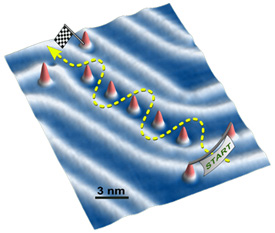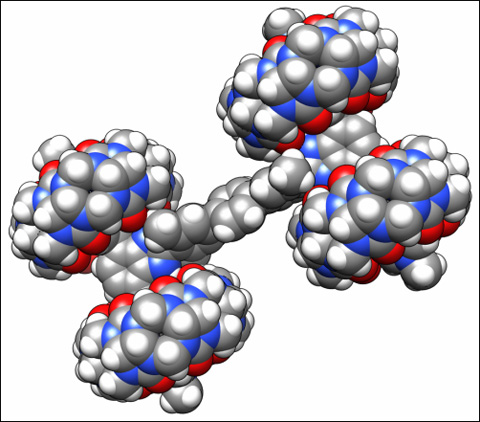Five teams from around the world—including one from Ohio University—rolled out their prototypes in France as the world awaits the first-ever international molecular nanocar race.
Over the next year, the OHIO Bobcat Nano-Wagon Team—along with competitors from France, Germany, Japan and USA/Austria—will get ready to race their nanocars along a tiny track made of gold. The Nanocar Race will be held in May 2017.
Constructing OHIO’s runway and driving the car will be Dr. Saw-Wai Hla, Professor of Physics & Astronomy, and building the Nanobobcat will be Dr. Eric Masson, Associate Professor of Chemistry & Biochemistry.
“The idea is to build a molecule that looks a bit like a car, to be able to visualize it by scanning tunneling microscopy (STM), and be able to move the car, or ‘drive’ it, using microscopy techniquesm” says Masson. “I am in charge of the design and synthesis of the molecule—the four wheels are my favorite pumpkin-shaped cucurbiturils—and Saw is of course the STM expert.”
The Nanocar Race Track
Picture a slalom skier twisting around the gates on snowy hill. Or a driver twisting through five orange cones on a test track. Now imagine that the snowy hill is the face of a crystalline gold surface. The orange cones are each one gold atom. It’s cold—minus 268 degrees Celsius—in an ultra-high vacuum. And it’s tiny. Those “orange cones” are less than 4 nanometers apart.

A preliminary runway constructed by C. Manzano and We Hyo Soe (A*Star, IMRE) in Singapore, with the 2 starting gold ad-atoms, the 5 gold ad-atoms for the track and the 2 gold ad-atoms had been already constructed atom by atom.
Over the course of two days, each team builds its own “runway” atom-by-atom on the same gold surface. “The construction and the imaging of a given runway are obtained by a low temperature scanning tunneling microscope (LT-UHV-STM) and certified by independent Track Commissioners before the starting of the race itself,” according to the Rules of the Grand Prix. The racers will compete at the same time.
The Nanobobcat
“The NanoCar Race is a race where molecular machines compete on a nano-sized track. A NanoCar is a single molecule-car (about 100 atoms) that has wheels and a chassis… and is propelled by a small electric shock,” according to the race website. “The race will be invisible to the naked eye: a unique microscope based in Toulouse, France, will make it possible to watch the competition. The NanoCar race is mostly a fantastic human and scientific adventure that will be broadcast worldwide.”
In the French southwestern town of Toulouse, the five teams presented their car prototypes during the Futurapolis event on Nov. 27.
“These cars, which only measure a few nanometers in length and are propelled by an electric current, are scheduled to compete on a gold atom surface next year,” says the news release. Participants will be able to synthesize and test their molecule-car until October 2016 prior to taking part in the NanoCar Race organized at the CNRS Centre d’élaboration des matériaux et d’études structurales (CEMES) by Christian Joachim, senior researcher at the CNRS and Gwénaël Rapenne, professor at Université Toulouse III-Paul Sabatier, with the support of the CNRS.”
Follow the race: #NanoCarRace.




















Comments